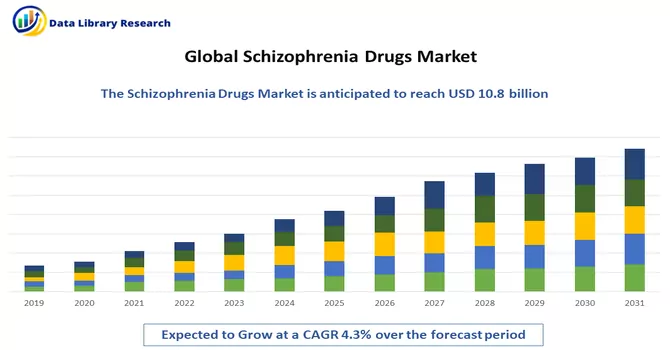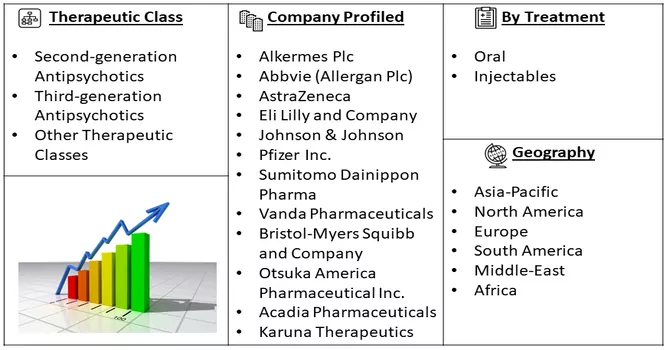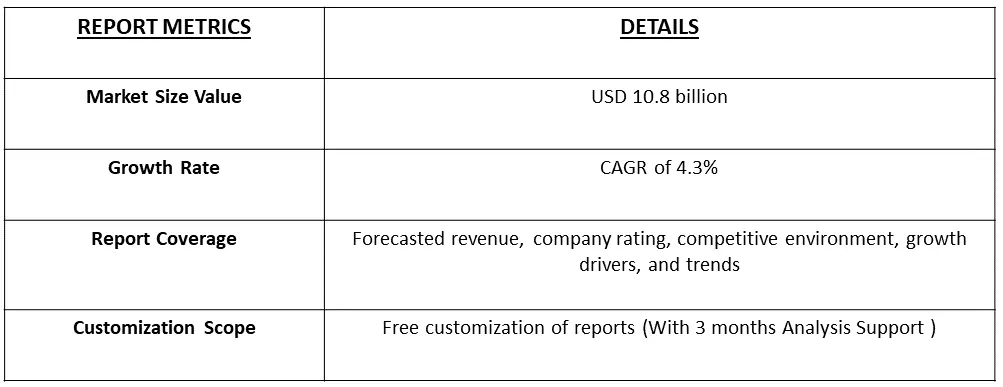The schizophrenia market size was USD 10.8 billion in 2022 and is expected to achieve a CAGR of more than 4.3% during 2023-2030.

Get Complete Analysis Of The Report - Download Free Sample PDF
Schizophrenia drugs are medications specifically designed to treat symptoms associated with schizophrenia, a complex mental health disorder characterized by distorted thinking, disrupted emotional responses, impaired social functioning, and altered perceptions of reality. These drugs aim to alleviate or manage the symptoms of schizophrenia, which may include hallucinations, delusions, disorganized thinking, and reduced motivation. These are older-generation antipsychotic medications that primarily block dopamine receptors in the brain. Some of the examples include haloperidol and chlorpromazine.
The factors that are driving factors for the studied market are the high prevalence of schizophrenia globally underscores the urgent need for effective pharmacological interventions. As a severe mental health disorder affecting millions of individuals, addressing the therapeutic requirements for schizophrenia is a primary driver for drug development. Schizophrenia presents a complex array of symptoms, including hallucinations, delusions, disorganized thinking, and impaired social functioning. The multifaceted nature of the disorder necessitates the development of drugs that target various aspects of symptomatology to provide comprehensive and effective treatment.
There is a growing trend toward personalized medicine in the field of schizophrenia treatment. Tailoring drug therapies to individual patient characteristics, including genetic and biological factors, is gaining importance to enhance treatment efficacy and minimize side effects. Moreover, the integration of digital therapeutics and supportive technologies, such as mobile apps and virtual reality, is becoming more prevalent. These tools are designed to assist in medication adherence, monitor symptoms, and provide additional support for individuals with schizophrenia. The recognition of mental health as a global priority has led to increased initiatives and campaigns to address mental health disorders, including schizophrenia. These efforts may contribute to a more supportive environment for research and development in this field.
Market Segmentation: The Schizophrenia Drugs Market is Segmented by Therapeutic Class (Second-generation Antipsychotics, Third-generation Antipsychotics, and Other Therapeutic Classes), Treatment (Oral and Injectables), and Geography (North America, Europe, Asia Pacific, Middle East and Africa, and South America). The report offers the value (in USD billion) for the above segments.

For Detailed Market Segmentation - Download Free Sample PDF
Market Driving :
Growing Burden of Schizophrenia and Associated Disorders
The growing burden of schizophrenia and associated disorders poses a significant public health challenge worldwide, impacting individuals, families, and healthcare systems. Schizophrenia, a severe mental health disorder, is characterized by disruptions in thought processes, emotional regulation, and social functioning. The burden extends beyond the affected individuals to include a range of associated disorders and challenges. Schizophrenia is a prevalent mental health disorder, affecting millions of people globally. Its prevalence varies across regions, but collectively, it contributes to a substantial portion of the global burden of mental health conditions.
As per the World Health Organization's data in 2022, schizophrenia impacts approximately 24 million individuals globally. This figure is expected to rise, aligning with the growth of the aging population. According to the United Nations' World Population Ageing Highlight 2020 report, the global geriatric population witnessed a significant increase, with around 727 million people aged 65 years or older constituting approximately 9.3% of the total global population in 2020. Projections from the same source indicate an anticipated surge to 1.5 billion individuals aged 65 years or above by the year 2050.
Moreover, estimates from the American Psychiatric Association and the National Institute of Mental Health suggest that the lifetime risk of an individual experiencing schizophrenia falls within the range of 0.3% to 0.7%. This data underscores the substantial and increasing prevalence of schizophrenia, emphasizing the need for heightened awareness, research, and interventions to address the challenges posed by this complex mental health disorder.
Increase in Focus of Governments and Health Care Organizations on Mental Health and Increasing Investments in R&D
There has been a notable increase in the focus of governments and healthcare organizations on mental health, accompanied by a corresponding rise in investments in research and development (R&D). This heightened attention reflects a growing recognition of the significance of mental health as a crucial component of overall well-being. The realization that mental health significantly influences societal well-being has prompted increased focus and investment. Mental health challenges not only impact individuals but also have broader societal implications, including reduced productivity, increased healthcare costs, and societal stigma. Thus, such factors are expected to witness significant growth over the forecast period.
Market Restraints
Increase in Cases of Addiction Associated with these Drugs and Patent Expiry of Major Drugs
The regulatory landscape surrounding the approval and marketing of schizophrenia drugs also influences market dynamics. Regulatory hurdles, including stringent requirements for safety and efficacy, can impact the speed at which new medications enter the market and compete with existing ones.
Moreover, the impending expiration of patents for major schizophrenia drugs poses a challenge to market growth. As patents expire, generic versions of these medications become available, leading to increased competition from lower-cost alternatives. This scenario often results in reduced market share and revenue for the original drug manufacturers. Thus, such factors are expected to slow down the growth of the studied market over the forecast period.
The COVID-19 pandemic led to disruptions in healthcare services globally, impacting the delivery of mental health care, including the treatment of schizophrenia. Lockdowns, restrictions, and overwhelmed healthcare systems affected the routine management and follow-up care for individuals with mental health disorders. The pandemic accelerated the adoption of telehealth services, including virtual consultations and remote monitoring. While this shift facilitated continued access to mental health care, it also posed challenges in terms of technology access and the ability to maintain the same level of care as in-person visits.
According to a May 2020 article titled "Schizophrenia and COVID-19 delirium," the global impact of COVID-19 has been substantial, with individuals diagnosed with schizophrenia facing an elevated risk of infection and related consequences. This heightened susceptibility is attributed to challenges in adhering to preventive measures and the presence of other medical comorbidities. The same source suggests that individuals with schizophrenia who contract COVID-19 may experience more severe symptoms compared to the general population.
Likewise, a 2020 article published by Europe PMC, titled "COVID-19 paranoia in a patient suffering from schizophrenic psychosis," reports that the pandemic triggered COVID-19-related hallucinations and delusions in a patient with schizophrenic psychosis. The patient also exhibited mood changes, including increased aggression. This highlights the significant and negative impact of the COVID-19 pandemic on the lives of individuals dealing with schizophrenia. However, with the resumption of healthcare services and procedures, there is optimism that the schizophrenia drugs market will gradually regain its full potential over the forecast period. The challenges posed by the pandemic have underscored the importance of mental health care, emphasizing the need for continued innovation and support for individuals managing schizophrenia in the evolving healthcare landscape.
Segmental Analysis:
Second Generation Antipsychotics Segment is Expected to Witness Significant growth Over the Forecast Period
The second-generation antipsychotics encompass a diverse group of medications, including clozapine, risperidone, olanzapine, quetiapine, aripiprazole, ziprasidone, and others. Each medication within this class has unique pharmacological properties, allowing for a range of options to address individual patient needs. SGAs are generally considered to be more effective than first-generation antipsychotics in treating both positive and negative symptoms of schizophrenia. Additionally, they are associated with a lower risk of extrapyramidal side effects, such as Parkinsonian symptoms. Clozapine, a second-generation antipsychotic, is particularly effective in treating treatment-resistant schizophrenia. It is often prescribed when other antipsychotic medications have not provided sufficient relief, demonstrating its significance in addressing challenging cases. Thus, such factors are expected to witness significant growth over the forecast period
Oral Segment is Expected to Witness Significant growth Over the Forecast Period
The choice of oral antipsychotic medications often involves a patient-centric approach, with shared decision-making between healthcare providers and patients. Factors such as patient preferences, tolerability, and treatment goals contribute to the selection of a particular oral medication. The oral drug segment has experienced the entry of generic versions of various antipsychotics as patents expire. This has led to increased competition and pricing dynamics within the market, affecting the market share of original branded medications. Thus, such factors are expected to witness significant growth over the forecast period.
North America Region is Expected to Witness Significant growth Over the Forecast Period
North America is poised to command a significant market share in the field of schizophrenia drugs, primarily driven by the escalating prevalence of schizophrenia and related mental disorders in the population. Factors such as a growing geriatric demographic, the presence of robust healthcare infrastructure, substantial healthcare spending, and the establishment of major market players contribute to this dominance.
The rising burden of mental illness and schizophrenia within the population stands out as a pivotal factor propelling market growth in the region. According to the National Alliance of Mental Illness (NAMI) update from June 2022, approximately 1.5 million adults in the United States grapple with schizophrenia annually. This prevalence underscores the demand for schizophrenia drugs in North America, fostering growth in the market. Notably, schizophrenia tends to affect individuals in their late teens to early twenties for men and late twenties to early thirties for women. Additionally, data from the World Health Organization in 2022 reveals that individuals with schizophrenia are two to three times more likely to experience premature mortality, often attributed to physical illnesses such as cardiovascular, metabolic, and infectious diseases.
Furthermore, companies are strategically leveraging various business initiatives, including collaborations, product launches, acquisitions, and partnerships, to fortify their positions in the schizophrenia drugs market, contributing to overall market growth. For example, in November 2021, Neurocrine Biosciences collaborated with Sosei Group Corporation to develop a novel protein inhibitor, aiming to enhance treatments for a broad spectrum of neuropsychiatric disorders. This partnership granted Neurocrine Biosciences the right to develop and produce muscarinic M4, M1, and dual M1/M4 receptor agonists discovered by Sosei Heptares. Neurocrine Biosciences plans to initiate a placebo-controlled phase 2 study with one of the M4 agonists for potential schizophrenia treatment by 2022. Similarly, in June 2020, Neurocrine Biosciences entered into a strategic collaboration with Takeda Pharmaceuticals to develop and commercialize compounds in Takeda's early-to-mid-stage psychiatry pipeline, including assets for schizophrenia, treatment-resistant depression, and anhedonia.
In essence, the mounting burden of mental illness, including schizophrenia, combined with the proactive focus on research and development by market players, is anticipated to fuel the expansion of the schizophrenia drugs market in North America throughout the forecast period.

Get Complete Analysis Of The Report - Download Free Sample PDF
The market for schizophrenia drugs is characterized by intense competition and features both prominent industry leaders and smaller players. Presently, major market players hold a dominant position in terms of market share, underscoring their substantial influence and market presence. The competitive landscape is marked by the participation of established pharmaceutical companies that play a pivotal role in shaping the trajectory of the schizophrenia drugs market. While smaller players contribute to the diversity of offerings, it is the major industry players that wield significant influence in determining market trends, innovations, and overall market dynamics.
Some of the key market players are
Recent Development
1) In February 2022, Vanderbilt University signed a worldwide license and a research collaboration agreement with Neumora Therapeutics to develop precision medicines for brain diseases through the integration of data science and neuroscience. The license program includes two new series of compounds that targets schizophrenia and other neuropsychiatric disorders.
2) In March 2022, AbbVie entered into a new co-development and license agreement with Gedeon Richter, to research, develop and commercialize novel dopamine receptor modulators for the potential treatment of neuropsychiatric diseases.
Q1. What was the Schizophrenia Drugs Market size in 2022?
As per Data Library Research the schizophrenia market size was USD 10.8 billion in 2022.
Q2. What is the Growth Rate of the Schizophrenia Drugs Market?
Schizophrenia Drugs Market is expected to achieve a CAGR of more than 4.3% during the forecast period.
Q3. Which region has the largest share of the Schizophrenia Drugs Market? What are the largest region's market size and growth rate?
North America has the largest share of the market. For detailed insights on the largest region's market size and growth rate request a sample here.
Q4. Who are the key players in Schizophrenia Drugs Market?
Some key players operating in the market include
Data Library Research are conducted by industry experts who offer insight on industry structure, market segmentations technology assessment and competitive landscape (CL), and penetration, as well as on emerging trends. Their analysis is based on primary interviews (~ 80%) and secondary research (~ 20%) as well as years of professional expertise in their respective industries. Adding to this, by analysing historical trends and current market positions, our analysts predict where the market will be headed for the next five years. Furthermore, the varying trends of segment & categories geographically presented are also studied and the estimated based on the primary & secondary research.
In this particular report from the supply side Data Library Research has conducted primary surveys (interviews) with the key level executives (VP, CEO’s, Marketing Director, Business Development Manager and SOFT) of the companies that active & prominent as well as the midsized organization
FIGURE 1: DLR RESEARH PROCESS

Extensive primary research was conducted to gain a deeper insight of the market and industry performance. The analysis is based on both primary and secondary research as well as years of professional expertise in the respective industries.
In addition to analysing current and historical trends, our analysts predict where the market is headed over the next five years.
It varies by segment for these categories geographically presented in the list of market tables. Speaking about this particular report we have conducted primary surveys (interviews) with the key level executives (VP, CEO’s, Marketing Director, Business Development Manager and many more) of the major players active in the market.
Secondary ResearchSecondary research was mainly used to collect and identify information useful for the extensive, technical, market-oriented, and Friend’s study of the Global Extra Neutral Alcohol. It was also used to obtain key information about major players, market classification and segmentation according to the industry trends, geographical markets, and developments related to the market and technology perspectives. For this study, analysts have gathered information from various credible sources, such as annual reports, sec filings, journals, white papers, SOFT presentations, and company web sites.
Market Size EstimationBoth, top-down and bottom-up approaches were used to estimate and validate the size of the Global market and to estimate the size of various other dependent submarkets in the overall Extra Neutral Alcohol. The key players in the market were identified through secondary research and their market contributions in the respective geographies were determined through primary and secondary research.
Forecast Model
